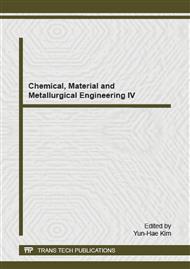[1]
Mendez, M.O. and R.M. Maier, Phytoremediation of mine tailings in temperate and arid environments. Rev. Environ. Sci. Bio/Technol., 2007. DOI: 10. 1007/s11157–007–9125–4.
DOI: 10.1007/s11157-007-9125-4
Google Scholar
[2]
Abreu, M.M., E.S. Santos, M.C.F. Magalhães, and E. Fernandes, Trace elements tolerance, accumulation and translocation in Cistus populifolius, Cistus salviifolius and their hybrid growing in polymetallic contaminated mine areas. Journal of Geochemical Exploration, 2012. 123(0): pp.52-60.
DOI: 10.1016/j.gexplo.2012.05.001
Google Scholar
[3]
Grandlic, C.J., M.O. Mendez, J. Chorover, B. Machado, and R.M. Maier, Plant Growth-Promoting Bacteria for Phytostabilization of Mine Tailings. Environmental Science & Technology, 2008. 42(6): p.2079-(2084).
DOI: 10.1021/es072013j
Google Scholar
[4]
Babu, A.G., J. Shim, K. -S. Bang, P.J. Shea, and B. -T. Oh, Trichoderma virens PDR-28: A heavy metal-tolerant and plant growth-promoting fungus for remediation and bioenergy crop production on mine tailing soil. Journal of Environmental Management, 2014. 132(0): pp.129-134.
DOI: 10.1016/j.jenvman.2013.10.009
Google Scholar
[5]
Meers, E., S. Van Slycken, K. Adriaensen, A. Ruttens, J. Vangronsveld, G. Du Laing, N. Witters, T. Thewys, and F.M.G. Tack, The use of bio-energy crops (Zea mays) for phytoattenuation, of heavy metals on moderately contaminated soils: A field experiment. Chemosphere, 2010. 78(1): pp.35-41.
DOI: 10.1016/j.chemosphere.2009.08.015
Google Scholar
[6]
Sheng, X., L. Sun, Z. Huang, L. He, W. Zhang, and Z. Chen, Promotion of growth and Cu accumulation of bio-energy crop (Zea mays) by bacteria: Implications for energy plant biomass production and phytoremediation. Journal of Environmental Management, 2012. 103(0): pp.58-64.
DOI: 10.1016/j.jenvman.2012.02.030
Google Scholar
[7]
Valentín-Vargas, A., R.A. Root, J.W. Neilson, J. Chorover, and R.M. Maier, Environmental factors influencing the structural dynamics of soil microbial communities during assisted phytostabilization of acid-generating mine tailings: A mesocosm experiment. Science of The Total Environment, 2014. 500–501(0): pp.314-324.
DOI: 10.1016/j.scitotenv.2014.08.107
Google Scholar
[8]
Petrisor, I.G., S. Dobrota, K. Komnitsas, I. Lazar, J.M. Kuperberg, and M. Serban, Artificial Inoculation—Perspectives in Tailings Phytostabilization. International Journal of Phytoremediation, 2004. 6(1): pp.1-15.
DOI: 10.1080/16226510490439918
Google Scholar
[9]
Wu, S.C., K.C. Cheung, Y.M. Luo, and M.H. Wong, Effects of inoculation of plant growth-promoting rhizobacteria on metal uptake by Brassica juncea. Environmental Pollution 2006. 140: pp.124-135.
DOI: 10.1016/j.envpol.2005.06.023
Google Scholar
[10]
Firdaus e, B., M. Shafiq, and S. Jamil, Role of plant growth regulators and a saprobic fungus in enhancement of metal phytoextraction potential and stress alleviation in pearl millet. Journal of Hazardous Materials, 2012. 237–238(0): pp.186-193.
DOI: 10.1016/j.jhazmat.2012.08.033
Google Scholar
[11]
Babu, A.G., J. Shim, P.J. Shea, and B. -T. Oh, Penicillium aculeatum PDR-4 and Trichoderma sp. PDR-16 promote phytoremediation of mine tailing soil and bioenergy production with sorghum-sudangrass. Ecological Engineering, 2014. 69(0): pp.186-191.
DOI: 10.1016/j.ecoleng.2014.03.055
Google Scholar


